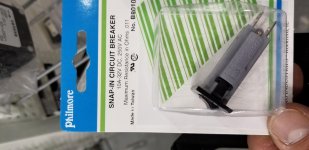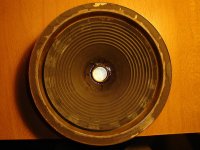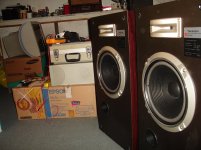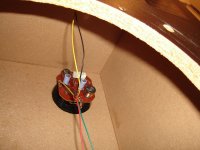I'm trying to figure out if there's a means to determine the specifications for "lamp" protection for a subwoofer driver, basically by examining the lamp's "cold" resistance to see how much of an impact it would have on the driver's Qts, and the lamp's "hot" resistance at a specified power level which is high enough to cause the lamp's voltage rating to be achieved (otherwise it won't be "hot").
... and this is turning my brain into mush, LOL.
I've worked out that low-voltage bulbs need to be used, primarily because the "cold" resistance is 1/10th or less than the "hot" resistance, and you'd want the "cold" resistance to be as low as possible to minimize the impact on the "Q" of the system. The "cold" resistance of a 12V 30W bulb will be much lower than that of a 120V 30W bulb, for example.
At higher wattage ratings, the "cold" resistance will be lower, so this favours using higher-wattage, low voltage lamps. However, if you do that, you run into the possibility of the lamp not seeing its rated voltage and therefore not providing the amount of compression that you might expect.
A worked example:
Consider a 12V 30W lamp wired in series with a driver with a 6.6 ohm Re, and driven with an amplifier capable of 100W RMS. If you work the numbers, at the amplifier's continuous output, the voltage across the bulb will be just about 12V, and the resulting power compression will be around 2.4dB, as the bulb's rated voltage.
Replace that bulb with a 12V 40W one, and that compression will be 1.9dB, but that's if the bulb has hit its "hot" resistance. As the voltage across the bulb will be only 10V however, the chance that it's achieved the "hot" resistance is low, and the compression effect will be less.
Am I on the right track here?
... and this is turning my brain into mush, LOL.
I've worked out that low-voltage bulbs need to be used, primarily because the "cold" resistance is 1/10th or less than the "hot" resistance, and you'd want the "cold" resistance to be as low as possible to minimize the impact on the "Q" of the system. The "cold" resistance of a 12V 30W bulb will be much lower than that of a 120V 30W bulb, for example.
At higher wattage ratings, the "cold" resistance will be lower, so this favours using higher-wattage, low voltage lamps. However, if you do that, you run into the possibility of the lamp not seeing its rated voltage and therefore not providing the amount of compression that you might expect.
A worked example:
Consider a 12V 30W lamp wired in series with a driver with a 6.6 ohm Re, and driven with an amplifier capable of 100W RMS. If you work the numbers, at the amplifier's continuous output, the voltage across the bulb will be just about 12V, and the resulting power compression will be around 2.4dB, as the bulb's rated voltage.
Replace that bulb with a 12V 40W one, and that compression will be 1.9dB, but that's if the bulb has hit its "hot" resistance. As the voltage across the bulb will be only 10V however, the chance that it's achieved the "hot" resistance is low, and the compression effect will be less.
Am I on the right track here?
You-think-too-much 
Seriously now, lamp bulbs are good protection for very light voice coils, with minimal thermal mass, because lamp filament is also very low mass and reacts quickly.
Also power involved is low.
Now a subwoofer has a huge heavy voice coil, with a long thermal time constant; if you want to protect it it´s way better to insert a limiter before the power amp and set it so power out can not damage the woofer, period.
Seriously now, lamp bulbs are good protection for very light voice coils, with minimal thermal mass, because lamp filament is also very low mass and reacts quickly.
Also power involved is low.
Now a subwoofer has a huge heavy voice coil, with a long thermal time constant; if you want to protect it it´s way better to insert a limiter before the power amp and set it so power out can not damage the woofer, period.
DJK (R.I.P) covered the 561 and 211 (same as 561: <0.5 ohms cold - 15 ohms hot) incandescent bulbs with polyswitch for tweeter in a 2001 post:
Audio Asylum Thread Printer
- guess some of those could be paralleled and 211 may still be pretty cheap (?)
I wonder if there are other - huskier bulbs more suited to woofer and even subwoofer duty? - a lot of incandescent are disappearing with the rise of cheap LED
1129, 17 Watts Miniature Incandescent Bulb, S8, Single Contact Bayonet (BA15s)
back up lights 1129 Stock 6V Park Parking Back Up Tail Light Turn Signal Lamps Bulbs Box Of 10 | eBay
Audio Asylum Thread Printer
- guess some of those could be paralleled and 211 may still be pretty cheap (?)
I wonder if there are other - huskier bulbs more suited to woofer and even subwoofer duty? - a lot of incandescent are disappearing with the rise of cheap LED
1129, 17 Watts Miniature Incandescent Bulb, S8, Single Contact Bayonet (BA15s)
back up lights 1129 Stock 6V Park Parking Back Up Tail Light Turn Signal Lamps Bulbs Box Of 10 | eBay
Last edited:
fwiw - here's some sockets to go with those lamps Amazon.com: uxcell 10 Pcs 1156 BA15S S25 Car Tail Brake Bulb LED Light Extension Socket: Gateway
are 30w lamps readily available ?
are 30w lamps readily available ?
I have a couple of Technics cabinets from the 70's that have a speaker overload protector, I think they use a simple circuit associated with a thermistor.
Why not use one of them?
What would be the advantage of using a DC incandescent lamp? It will light up when the power is increased to dangerous levels for the speaker, but it will not be so fast as to interrupt it before the damage .....
Why not use one of them?
What would be the advantage of using a DC incandescent lamp? It will light up when the power is increased to dangerous levels for the speaker, but it will not be so fast as to interrupt it before the damage .....
Now a subwoofer has a huge heavy voice coil, with a long thermal time constant; if you want to protect it it´s way better to insert a limiter before the power amp and set it so power out can not damage the woofer, period.
Woofers come in various sizes and power handling capabilities.
The one I'm specifically thinking about in this particular application is rated at 70W RMS and has a 1.48" diameter voice coil, quite a bit of a step down from the larger and heavier drivers that I normally work with.
are 30w lamps readily available ?
I was looking at 12V halogen bulbs, like the ones at the link below.
Eiko JC12V30W T-3 G4 Base Halogen Bulb, 30W/12V - - Amazon.com
I'm assuming you need speaker protection on a very tight budget.
If that is the case, why not use a diode clipper.
https://www.electronics-tutorials.ws/diode/diode-clipping-circuits.html
If that is the case, why not use a diode clipper.
https://www.electronics-tutorials.ws/diode/diode-clipping-circuits.html
An active compressor/limiter circuit is the best option for a high power subwoofer, not a lightbulb. The circuit at the link above is a good approach.
I created a LADSPA lookahead limiter plugin at one time. There might be other DIY DSP options like that floating around that will do hard limiting and/or compression.
Loudspeaker protector SB 1950 Technics
This picture is taken when I repairing the twoofers, but I can not be sure if they protect the twoofer or the horn tweeter.
This picture is taken when I repairing the twoofers, but I can not be sure if they protect the twoofer or the horn tweeter.
Attachments
Last edited:
If that is the case, why not use a diode clipper.
That kind of protection requires a series resistance, something you want to avoid with woofers.
on the cheap, would a polyswitch of appropriate rating in parallel with the bulb be useful ? I've accidentally smoked a 3" diameter coil in a couple of minutes (sine) with a 100W amp.
That's an interesting idea. The use of a suitably-sized polyswitch in parallel with the lamp will keep the impedance low, and if it triggers, the lamp will allow the woofer to continue to play, albeit at reduced power with some compression applied to the signal.
Of course, the challenge is to suitably size the lamp and polyswitch to ensure that they apply the appropriate protection when needed.
An active compressor/limiter circuit is the best option for a high power subwoofer, not a lightbulb. The circuit at the link above is a good approach.
Use of line-level circuits is not one of the options available for this particular usage.
Woofers come in various sizes and power handling capabilities.
The one I'm specifically thinking about in this particular application is rated at 70W RMS and has a 1.48" diameter voice coil, quite a bit of a step down from the larger and heavier drivers that I normally work with.
In any case it´s **WAY** stronger and heavier than *ANY* driver/tweeter voice coil.
The point being that any woofer is a poor candidate for lamp bulb protection.
If anything, use a fuse.
They can be had in any rating, and do not annoyingly disturb sound the way a PTC resistor does.
.Originally Posted by Bill Coltrane View Post
If that is the case, why not use a diode clipper
But that´s *exactly* what you are doing, when adding a series lamp.That kind of protection requires a series resistance, something you want to avoid with woofers.
Sorry, can´t find any protector in the pictures.Loudspeaker protector SB 1950 Technics
This picture is taken when I repairing the twoofers, but I can not be sure if they protect the twoofer or the horn tweeter.
In any case, if you mean some small bimetallic circuit breaker, it´s probably for the tweeter.
Last edited:
If anything, use a fuse.
Using a fuse would cut power completely to the driver if the fuse blows, which is something I'm trying to avoid.
But that´s *exactly* what you are doing, when adding a series lamp.
The lamp's cold resistance, particularly the ones I'm considering, is very low in the calculated range of 0.2~0.3 ohms, and likely less than that.
- Status
- This old topic is closed. If you want to reopen this topic, contact a moderator using the "Report Post" button.
- Home
- Loudspeakers
- Subwoofers
- Lamp protection for subwoofer drivers...



